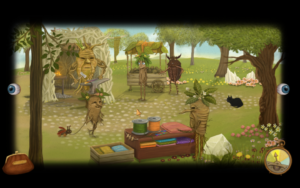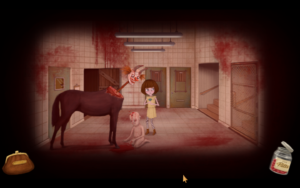Fran Bow: Conclusion
 After Fran leaves Ithersta, things become weirdly normal for a while. Just for a while, before the final plunge into unreality. We’ve had disturbing visions of ghosts and demons, and we’ve had a full-on fantasy world, and now, at the end, we get Ditkoesque surrealism, with strangely-connected floating platforms hosting odd creatures with odd obsessions. Fran isn’t afraid of them; her capacity to feel fear has long since burnt out. Indeed, one of the more frightening beings from earlier, a very tall skeleton in a top hat, turns out to be a friend and ally. The game does an excellent job of keeping this ambiguous, too, making it seem like he’s betrayed us once we’ve come to trust him. But once Fran has been through that, she can even accept help from her doctor from the hospital. There’s a sudden emphasis on keys and unlocking in the final chapter, and it’s clearly a sign that Fran is making breakthroughs.
After Fran leaves Ithersta, things become weirdly normal for a while. Just for a while, before the final plunge into unreality. We’ve had disturbing visions of ghosts and demons, and we’ve had a full-on fantasy world, and now, at the end, we get Ditkoesque surrealism, with strangely-connected floating platforms hosting odd creatures with odd obsessions. Fran isn’t afraid of them; her capacity to feel fear has long since burnt out. Indeed, one of the more frightening beings from earlier, a very tall skeleton in a top hat, turns out to be a friend and ally. The game does an excellent job of keeping this ambiguous, too, making it seem like he’s betrayed us once we’ve come to trust him. But once Fran has been through that, she can even accept help from her doctor from the hospital. There’s a sudden emphasis on keys and unlocking in the final chapter, and it’s clearly a sign that Fran is making breakthroughs.
The thing is, though, a completely surreal environment isn’t nearly as jarring and uncanny as an only slightly weird one. And that’s what we get in the lead-up to the ending. Fran somehow makes it back to her house, as has been her goal for the last couple of chapters. It’s an ordinary house, on an ordinary street, and the break in the unreality makes us suddenly uneasy about her unrealistic expectations. Fran just escaped from a madhouse. Her parents are dead. Things aren’t going to go back to normal just because she’s in the right place, but Fran doesn’t seem to realize this.
And then… things start to get rather silly. There’s a conspiracy of sorts going on. We got some inkling of this back in the hospital, where you could find indications that the labels on the magic pills had been deliberately switched, but when we start to learn the details of what was going on, it just doesn’t seem plausible, even though five minutes ago a skeleton in a top hat threw us a birthday party. The doctor from the hospital caught wind of the truth, and is investigating, and as part of his investigation, he invites Fran to help him dig up her parents’ graves — not because there’s anything in particular that he’s looking for, but just because he feels that showing an insane little girl the corpses of her parents would be a good idea somehow. Later, Fran’s aunt matter-of-factly claims, to all appearances expecting to be believed, that Fran’s parents were murdered by the cat. (Even Fran isn’t crazy enough to buy that.) Probably none of this would bother me if the Great Wizard back in Ithersta was doing it, but in the mundane world, it stands out.
There’s a lot we have to accept by the end that we didn’t have to accept in the very beginning: that Fran is special, that her otherworlds are objectively real, that the grown-ups in her life are plotting against her. That returning to her fantasy world is a positive development, and not just a retreat from reality. But I’m here for that. I’m going to recommend this game. The puzzles are nothing to write home about, and I have some reservations about its depiction of mental illness, but it’s got style, and it’s got heart. If character motivations get weird towards the end, it’s because it’s not really trying to be realistic, even in the reality scenes. Rather, it’s trying to depict a feeling, or a series of feelings, a progression from helplessness and victimization to empowerment, from horror to peace.
 Comments(0)
Comments(0)
